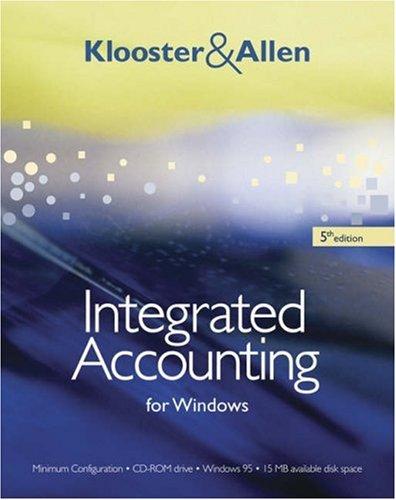Question
1. The assets of Quinn's business increased by $40,000 and the liabilities increased by $5,000 during the current year. If the profit for this period
1. The assets of Quinn's business increased by $40,000 and the liabilities increased by $5,000 during the current year. If the profit for this period was $25,000, what additional contribution or withdrawal was made by the owner? (Assume only a withdrawal or a contribution was made).
A. Drawings $10,000
B. Contribution $10,000
C. Contribution $5,000
D. Drawings $5,000
E. Contribution $15,000
2. If a sole proprietor who owns an electrical store takes home a DVD player for his own personal use it would be considered to be:
A. An expense because an asset has been given away
B. An increase in equity and a decrease in assets because the proprietor now owns the DVD player
C. A decrease in assets and a decrease in equity because by taking the DVD player the owner has made a drawing from the business
D. An increase in assets and an increase in equity
E. None of the above
3. The correct classification for the following is:
1. land
2. accounts receivable
3. sales revenue
4. accounts payable
A. 1 asset 2 liability 3 income 4 asset
B. 1 asset 2 asset 3 liability 4 liability
C. 1 asset 2 liability 3 liability 4 liability
D. 1 asset 2 liability 3 asset 4 liability
E. 1 asset 2 asset 3 income 4 liability
4. If: assets at beginning = $20,000
liabilities at beginning = $11,500
income for the period = $36,900
equity at end = $9,600
what was the amount of expense for the period?
A. $35,800
B. $26,200
C. $16,600
D. $24,300
E. None of the above
5. The cost of replacing an item is known as its:
A. Market cost.
B. Current cost.
C. Present value.
D. Historical cost.
E. Fair value.
6. $45,000 is owed to suppliers for inventory purchases at the beginning of the year and $24,000 is owed at the end of the year. If annual credit purchases of inventory are $120,000, the cash paid to suppliers for the year is:
A. $141,000
B. $99,000
C. $165,000
D. $144,000
E. None of the above
7. If production is increased by 10%, total variable cost will
A. increase by 10%.
B. decrease by 10%.
C. increase by more than 10%.
D. Not change
E. None of the above
8. A product has $3 variable costs, $20,000 fixed costs and a profit target of $20,000. If 10,000 units are to be sold, the price they should be sold for is:
A. $4 per unit
B. $6 per unit
C. $8 per unit
D. $10 per unit
E. None of the above
9. Which of these is an indirect cost if the cost object is the delivery department of a motor bike manufacturer?
A. Wages of delivery truck drivers
B. Petrol for delivery vehicles
C. Spare parts for the delivery vehicles
D. Council rates
E. All of the above
10. Identify the unfavourable variance.
A. Budgeted income $100,000; actual income $105,000
B. Budgeted expenses $80,000; actual expenses $85,000
C. Budgeted expenses $32,000; actual expenses $28,000
D. Budgeted loss $20,100; actual loss $17,500
E. None of the above
11. Which of these is not a commonly prepared budget?
A. Cash budget
B. Purchases budget
C. Depreciation budget
D. Capital budget
E. All are commonly prepared budgets
12. Rich Company Pty Ltd made these estimates for the three months ending 30 June 2020, its first period of operation.
Estimated:
Cash receipts from sales $300,000
Cash payments for expenses 130,000
Purchase of fixed asset ($5,000 will not be paid until August) 20,000
Depreciation of fixed assets 15,000
Repayment of a loan 100,000
What is the estimated cash balance at 30 June 2020?
A. $40,000 surplus
B. $55,000 surplus
C. $155,000 surplus
D. $50,000 surplus
E. $55,000 deficit
13. An investment with a high risk margin has a high discount rate, which makes the net present value
A. higher.
B. lower.
C. unchanged as the risk has no effect on the NPV.
D. zero.
E. None of the above
14. The internal rate of return of a project is the rate that leads to a net present value that is
A. as low as will be accepted by management.
B. zero.
C. high enough for management to accept.
D. as high as possible.
E. None of the above
15. A company is evaluating an investment proposal using the payback method. Cash inflows are expected to be $16,000 in year 1, $12,000 in year 2 and $8,000 in year 3. The initial investment required is $32,000. Assuming even cash inflows within each year the payback period is:
A. 2 years
B. 2.25 years
C. 2.5 years
D. 2.6 years
E. 3 years
Step by Step Solution
There are 3 Steps involved in it
Step: 1

Get Instant Access to Expert-Tailored Solutions
See step-by-step solutions with expert insights and AI powered tools for academic success
Step: 2

Step: 3

Ace Your Homework with AI
Get the answers you need in no time with our AI-driven, step-by-step assistance
Get Started


